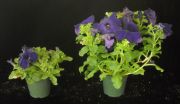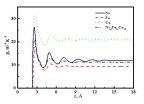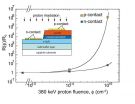(Press-News.org) WEST LAFAYETTE, IN/ITHACA, NY - Energy costs account for one of the largest expenses in commercial greenhouse production of annual bedding plants. Naturally, bedding plant producers are searching for more energy-efficient production methods that can reduce fuel usage and increase profits. Christopher Currey, Roberto Lopez, and Neil Mattson published a study in HortTechnology that gives growers in northern latitudes valuable information on finishing practices for annual bedding plants. The researchers compared traditional heated greenhouses with unheated high tunnels for growing 10 popular bedding plants at two USDA Hardiness Zone 5 locations: Ithaca, New York, and Lafayette, Indiana.
According to the researchers, energy for heating commercial greenhouses in northern climates can account for 10-30% of total operating costs. "In floriculture, high tunnels are traditionally used in cut flower production for season extension and frost protection," the authors said. "Though not designed to be equivalent to greenhouses for year-round protected crop cultivation, high tunnels have the potential to be used for seasonal crop cultivation." Daytime air temperatures inside high tunnels can range from 5-20 °C warmer than ambient outdoor air temperatures, but temperatures at night in unheated high tunnels can be about the same or occasionally lower than outdoor air temperatures.
The scientists grew 10 popular bedding plants (angelonia, vinca, celosia, dianthus, geranium, petunia, french marigold, viola, snapdragon, and osteospermum) in both an unheated high tunnel and a glass-glazed greenhouse with an 18 °C temperature set point at both Cornell University and Purdue University.
At Cornell, all 10 species survived in the unheated high tunnel environment when moved on April 1. The lowest recorded temperature at the Cornell high tunnel was -3.2 °C. "It is interesting to note that the cold-sensitive species angelonia, celosia, and vinca survived this short-term cold exposure," said corresponding author Roberto Lopez. However, most of the species showed a significant delay in flowering when grown in the high tunnel compared to when they were grown in the heated greenhouse. Although seven of the species exhibited a delay in flowering in the high tunnel compared with those in the heated greenhouse, there were no differences in days to flower for geranium, osteospermum, and viola grown at Cornell, and viola grown at Purdue.
At Purdue, several species were lost because of a cold temperature event (-6 °C), necessitating a second planting (April 8). "Delaying the high tunnel transplant date was an effective method for reducing plant mortality and reducing delays in days to flower because of the cold temperature environment of the high tunnel," the authors said. For the second planting, osteospermum was the only species that flowered significantly later in the high tunnel, a delay of 7 days compared to the greenhouse-grown plants.
According to author Neil Mattson, besides savings in energy costs, finishing cold-tolerant bedding plants in unheated high tunnels may enable growers to meet their seasonal peak space demand in a cheaper-to-build high tunnel while still providing some protection compared to the outside environment. "Further, in the current study finishing bedding plants in high tunnels led to improvements in measures of plant quality for some crops, such as shorter, more compact plants than greenhouse-grown counterparts. This could reduce the need for application of chemical plant growth regulators."
The authors concluded that production of cold-tolerant annuals in unheated or minimally heated high tunnels can be a "viable alternative" for commercial producers aiming to reduce energy costs. "While we acknowledge the risk of finishing spring bedding plant crops in an unheated environment, there is a potential for gains in profitability for producers because of the lower capital and energy costs of high tunnels as compared with conventional greenhouses," the authors said.
INFORMATION:
The complete study and abstract are available on the ASHS HortTechnology electronic journal web site:
http://horttech.ashspublications.org/content/24/5/527.abstract
Founded in 1903, the American Society for Horticultural Science (ASHS) is the largest organization dedicated to advancing all facets of horticultural research, education, and application. More information at ashs.org
(SAN FRANCISCO, December 6, 2014) - New treatment combinations and targeted therapies for lymphoma and multiple myeloma are improving outcomes for vulnerable patient populations with hard-to-treat disease, according to studies presented today at the 56th American Society of Hematology (ASH) Annual Meeting and Exposition.
Despite advances in lymphoma treatments, improving the prognosis for patients with relapsed and treatment-resistant disease remains a challenge. The early success of several precision therapies associated with fewer side effects than conventional approaches ...
(SAN FRANCISCO, December 7, 2014) - Studies presented at the 56th American Society of Hematology (ASH) Annual Meeting and Exposition compare new and standard-of-care treatments for blood clots and further illuminate clot risks in vulnerable populations, such as cancer patients.
Although significant advances have been made in the treatment and prevention of blood clots through new and improved therapies for clotting disorders, challenges remain in balancing the benefits and risks of these therapies. Specifically, while these treatments can reduce patients' risk of suffering ...
It is estimated that about 35 million people worldwide currently suffer from dementia and it is expected that the number will increase to 135 million by the year 2050. The disease is already one of the most common health problems in the elderly, which is why experts predict that the numbers of people affected will increase over time. Researchers at the Department of Psychiatry and Psychotherapy of the University Medical Center of Johannes Gutenberg University Mainz (JGU) have recently gained new insights into how it may in future be possible to treat patients with the currently ...
The ability to predict macroscopic physical and chemical properties from information derived at the micro-scale or atomic scale for various kinds of materials has yet to be perfected in the field of materials physics and chemistry. Although macro-scopic properties are determined by the micro or atomic structure of materials, it is still difficult to obtain such properties as hardness, intensity, surface tension, density, thermal expansion, thermal diffusion, viscosity and specific heat from a cell with just several atoms because of multi-scale effects.
For solids, particularly ...
Gallium nitride (GaN) based devices are attractive for harsh environment electronics because of their high chemical and the mechanical stability of GaN itself that has a higher atomic displacement energy than other semiconductor materials.
However, degradation mechanisms of GaN device under radiation environments is not clear mainly because devices consist of many different types of semiconductors, such as p-type and n-type layers in light emitting diode (LED), and each layer has different hardness to radiation.
Now, researchers at the Electronics-Inspired Interdisciplinary ...
Macrophages are best known for their Pac Man-like ability to gobble up cellular debris and pathogens in order to thwart infection. A new study in The Journal of Cell Biology describes how these immune cells also help resolve inflammation by inducing white blood cells called neutrophils to leave wounded tissue.
Neutrophils are "first responders" that are attracted to wounds by signaling molecules called reactive oxygen species (ROS) that activate a protein kinase. When neutrophils finish their work, inflammation is partly resolved through apoptosis, or cell suicide, and ...
What does it mean for expectant mothers and hospitals when there are large-scale closures of maternity units? A new study led by researchers at The Children's Hospital of Philadelphia provides an inside view from hospital staff members in Philadelphia, where 13 out of 19 obstetric units closed in a 15-year period.
The researchers found that sharp surges in patient volume in the remaining units strained the healthcare system, eroded workforce morale, and fragmented care for mothers and babies until hospitals adjusted to added demands.
"While the degree of obstetric ...
WASHINGTON, DC (December 8, 2014)-- Despite the promise of health reform, millions of U.S. children still lack quality health coverage or have trouble getting the services they need to stay healthy or to develop properly, according to two articles published in the December issue of Health Affairs. To address these gaps in coverage, broad reforms aimed at improving the quality of coverage for all children are needed, according to the authors.
In the first article, Sara Rosenbaum, JD, the Harold and Jane Hirsh Professor of Health Law and Policy at Milken Institute School ...
WASHINGTON, DC - December 9, 2014 - Seasonal flu vaccines may protect individuals not only against the strains of flu they contain but also against many additional types, according to a study published this week in mBio®, the online open-access journal of the American Society for Microbiology.
The work, directed by researchers at St. Jude Children's Research Hospital in Memphis, Tenn., found that some study participants who reported receiving flu vaccines had a strong immune response not only against the seasonal H3N2 flu strain from 2010, when blood samples were ...
San Francisco children living in non-redeveloped public housing are 39 percent more likely to repeatedly visit emergency rooms, according to new research from UC San Francisco and UC Berkeley.
"The average emergency department (ED) visit costs two to five times more than an office visit, and many children visit EDs for potentially preventable reasons," said Nancy Adler, PhD, senior author of the research, and vice chair of the department of psychiatry and director of the Center for Health and Community at UCSF. "There is a clear need to better understand the range of ...




